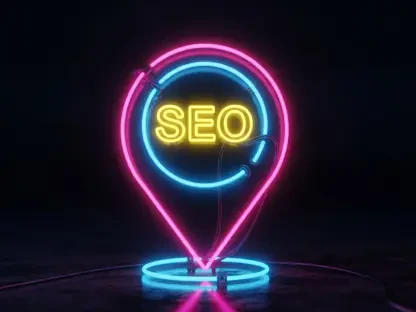Setting the Stage for Digital Out-of-Home Impact
In a bustling urban center, commuters rush past vibrant digital screens displaying dynamic video ads for a new product launch, their attention briefly captured amid the morning chaos, while at home, the same campaign flickers across television screens during prime-time slots, embedding the brand deeper into viewers’ minds. A recent study reveals that such a strategic combination of Digital Out-of-Home (DOOH) advertising with traditional TV can achieve an astonishing 90% assisted ad recall rate, redefining how brands connect with fragmented audiences. This striking statistic underscores a pivotal shift in the advertising landscape, where DOOH emerges as a critical amplifier in video campaigns. This report delves into the mechanisms behind these impressive results, exploring the current state of the industry and the transformative potential of integrated media strategies.
The advertising ecosystem today faces unprecedented challenges with audience fragmentation, driven by the rise of streaming platforms and declining traditional TV viewership. DOOH stands out as a dynamic solution, offering high-visibility placements in public spaces that complement other video formats. With approximately 111,000 screens in the German market alone, this medium has become a cornerstone for advertisers aiming to maintain reach in an increasingly dispersed media environment. Key players like Ströer and WallDecaux lead the charge, leveraging advanced technologies to integrate DOOH seamlessly with TV and online video, creating a cohesive cross-channel experience.
Understanding Digital Out-of-Home (DOOH) Advertising in Today’s Landscape
DOOH has solidified its position as an essential component of the modern advertising ecosystem, particularly within video advertising. Unlike static billboards, these digital screens deliver dynamic, contextually relevant content in high-traffic locations such as transit hubs, shopping centers, and urban streets. This format captures attention in moments of daily routine, making it a powerful tool for brand exposure. Its ability to adapt quickly to real-time data and trends further enhances its appeal to marketers seeking agility in campaign execution.
In the German market, the scale of DOOH is impressive, with over 111,000 screens providing extensive coverage across indoor and outdoor environments. Major operators like Ströer and WallDecaux dominate this space, driving innovation through partnerships and infrastructure expansion. The integration of DOOH with traditional TV and online video formats, such as in-stream pre-rolls and mobile out-stream ads, allows for a unified storytelling approach that resonates across touchpoints. This convergence amplifies campaign impact, bridging the gap between broad reach and targeted engagement.
Technological advancements, particularly programmatic buying, have revolutionized DOOH deployment, enabling automated, data-driven ad placements. This shift toward automation aligns with the broader media landscape’s fragmentation, where audiences are scattered across multiple platforms. By offering a scalable, visually compelling medium, DOOH helps advertisers cut through the clutter, ensuring messages remain visible in a world of endless digital distractions. Its role as a complementary channel continues to grow, reshaping how media plans are constructed.
Key Findings from the Moving Image Equivalence Study
Breakthrough Recall Rates and Synergistic Effects
A groundbreaking study conducted in Germany, involving 1,200 participants through realistic media consumption simulations, has unveiled the remarkable potential of DOOH in video advertising mixes. The research highlights a peak assisted advertising recall rate of 90% when campaigns combine two TV contacts with two DOOH exposures. This figure starkly contrasts with mono-media results, such as 80% recall for four TV-only contacts or just 52% for DOOH alone, demonstrating the power of cross-channel synergy.
The synergistic effects of pairing DOOH with other media are evident across multiple metrics. When integrated with TV, DOOH not only boosts recall but also elevates brand awareness, achieving up to 89% unaided recognition in optimal mixes. This combination proves particularly effective for upper-funnel objectives, where establishing a strong brand presence is key. For lower-funnel goals like activation, DOOH paired with online video formats shows promising results, further illustrating its versatility in driving consumer action.
Data from the study emphasizes that mixed-media approaches create a compounding impact, where each channel enhances the other’s strengths. Advertisers leveraging this strategy can expect a more memorable and engaging experience for their target audience. These findings signal a clear departure from outdated single-channel campaigns, pointing toward a future where integrated plans dominate the industry.
Market Insights and Performance Metrics
Delving deeper into the study’s data, effectiveness indices provide a quantifiable measure of DOOH’s impact within various media combinations. A mix of three DOOH contacts and one TV contact achieves an effectiveness index of 111, a significant leap from the 65 recorded for four DOOH-only exposures. Such metrics underscore the value of strategic balance over sheer volume, with four contacts identified as the optimal frequency before diminishing returns set in.
These insights offer actionable guidance for media planning and budget allocation. For instance, a 3:1 distribution favoring TV alongside DOOH maximizes brand awareness, while an equal split optimizes recall. Looking ahead, DOOH’s role is expected to expand, with projections indicating increased investment in cross-media campaigns as advertisers recognize the efficiency of these mixes. The ability to fine-tune contact frequencies ensures resources are deployed with precision, enhancing overall campaign performance.
The study also suggests that these performance metrics can shape long-term strategies. As DOOH continues to gain traction, its cost-effectiveness compared to premium TV slots positions it as a viable option for extending reach without inflating budgets. This data-driven approach equips marketers with the tools to navigate complex media environments, prioritizing combinations that deliver measurable results.
Challenges in a Fragmented Media Environment
The decline of traditional TV viewership poses a significant hurdle for advertisers, with streaming now accounting for 44.8% of total consumption according to recent Nielsen data. This shift fragments audiences across platforms, making it harder to achieve consistent reach through conventional channels. As viewers migrate to on-demand content, the challenge of maintaining campaign visibility intensifies, necessitating alternative avenues like DOOH to bridge the gap.
Measuring cross-channel effectiveness remains a persistent issue, as disparate methodologies and metrics complicate the evaluation of integrated campaigns. Combining DOOH with TV or online video requires reconciling different attribution models, often leading to incomplete insights. This lack of standardization hinders the ability to fully assess the incremental lift provided by each medium, creating uncertainty in media planning.
Solutions to these challenges lie in adopting data-driven planning frameworks and standardized measurement approaches. By leveraging unified metrics such as assisted recall over traditional impressions, advertisers can better capture the true impact of cross-media strategies. Collaborative efforts across the industry to establish common benchmarks will further streamline integration, enabling a clearer understanding of how DOOH contributes to overall campaign success.
Regulatory and Technical Developments Impacting DOOH
The regulatory landscape for DOOH is evolving rapidly, with new requirements shaping how inventory is monetized and managed. Google’s updated standards for Connected TV (CTV) and DOOH, effective from May 1 of this year, mandate stricter compliance for ad transactions, pushing for greater transparency and accountability. These changes aim to align digital out-of-home practices with broader video advertising norms, ensuring fair market participation.
Compliance with emerging standards extends beyond individual platforms, with a growing emphasis on unified ad tracking systems across regions like Europe and the US. Such systems facilitate cross-platform attribution, addressing the measurement challenges inherent in fragmented media. Adhering to these guidelines is crucial for operators and advertisers alike, as non-compliance risks exclusion from key programmatic marketplaces, limiting campaign scalability.
These regulatory and technical shifts directly influence DOOH execution, emphasizing the need for robust infrastructure to support seamless monetization. Enhanced technical compliance ensures that campaigns run smoothly across diverse environments, from urban digital screens to connected devices. As these frameworks mature, they pave the way for more sophisticated integrations, reinforcing DOOH’s position as a reliable partner in video advertising.
Future Outlook for DOOH in Video Advertising
Looking toward the horizon, DOOH is poised for substantial growth, particularly through programmatic channels, with global spend projected to rise from $19 billion this year to $25 billion by 2029. This upward trajectory reflects increasing confidence in automated buying, which streamlines ad placement and optimizes performance through real-time data. As programmatic adoption accelerates, DOOH’s accessibility to a wider range of advertisers will likely expand.
Emerging trends such as the dominance of streaming and the anticipated doubling of CTV ad spend by next year further underscore the importance of complementary channels like DOOH. Positioned as a bridge between broad-reach TV and precision-targeted digital video, this medium offers unique opportunities to engage audiences in physical spaces. Its ability to adapt to shifting consumption patterns ensures relevance amid rapid industry changes.
Potential disruptors, including global economic fluctuations and evolving consumer behaviors, could shape DOOH strategies in unforeseen ways. Innovations in creative formats, such as interactive or augmented reality displays, promise to elevate engagement, while economic pressures may drive demand for cost-efficient media like DOOH. Staying ahead of these dynamics will require continuous experimentation and a willingness to embrace cutting-edge approaches in campaign design.
Strategic Takeaways and Closing Reflections
Reflecting on the insights unearthed by the comprehensive study in Germany, it becomes evident that DOOH holds transformative power in elevating video ad recall to an impressive 90% within mixed-media campaigns. The research underscores the unparalleled synergy of combining DOOH with TV for brand awareness, while digital mixes prove more effective for activation goals. These findings mark a turning point, highlighting the necessity of moving beyond outdated mono-media tactics to embrace integrated strategies.
As a path forward, advertisers are encouraged to prioritize testing TV and DOOH combinations to capitalize on high recall rates for upper-funnel objectives, allocating budgets to achieve optimal contact frequencies. For conversion-driven campaigns, a pivot to DOOH paired with online video offers a compelling solution, leveraging precise targeting alongside broad exposure. Investing in programmatic tools emerges as a critical step to streamline execution and maximize efficiency across channels.
Beyond immediate actions, the industry is urged to focus on developing standardized measurement systems to better capture cross-media effects, ensuring that DOOH’s contributions are accurately valued. Continued innovation in creative formats and sequential timing strategies also holds promise for sustaining audience engagement. These steps, taken collectively, position DOOH as an indispensable asset in navigating the complexities of modern advertising landscapes, paving the way for sustained impact and growth.









